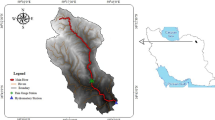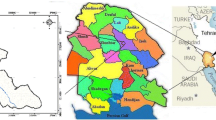Abstract
This research has been carried out for investigation and comparison of the accuracy and reliability of different methods of unit hydrograph estimation, including geomorphologic (GIUH) and geomorphoclimatic (GCIUH) methods as well as methods by Nash (Nash-IUH), Rosso (Rosso-IUH) and the Soil Conservation Service (SCS); the methods simulated the rainfall-runoff process over the Manshad River basin located in central Iran. The first six equivalent rainfall-runoff events were selected, and a hydrograph of outlet runoff was calculated for each event. Compared were peak time, peak discharge, base time, W 50 and W 75 parameters (hydrograph widths at 50% and 75% of peak discharge) and the volume of outlet runoff simulated by the models; then determined was the model that most efficiently estimated the hydrograph of outlet flow. The comparison of calculated and observed hydrographs showed that the Nash model was more efficient in estimating peak discharge, peak time, outlet runoff volume and the shape of direct surface runoff (DSRO) hydrographs, though it could not precisely simulate base time and W 50 and W 75 parameters. The other methods were more accurate in simulating outlet runoff volume of the hydrographs. The Rosso-IUH and SCS models could estimate the base time parameter better than the others. GIUH performance was comparable to the Nash method and was relatively suitable. In spite of these results, the GIUH, GCIUH, Rosso-IUH and SCS models had weak performance for estimating other characteristics of outlet DSRO hydrographs.
Similar content being viewed by others
References
U. Agirre, M. Goni, J. J. Lopez, and F. N. Gimena, “Application of a Unit Hydrograph Based on Sub Watershed Division and Comparison with Nash Instantaneous Unit Hydrograph,” J. Catena, No. 2–3, 64 (2005).
M. M. Ahmad, A. R. Ghumman, and S. Ahmad, “Estimation of Clark’s Instantaneous Unit Hydrograph Parameters and Development of Direct Surface Runoff Hydrograph,” J. Water Resour. Manag., 23 (2009).
M. M. Ahmad, A. R. Ghumman, S. Ahmad, and H. N. Hashmi, “Estimation of a Unique Pair of Nash Model Parameters: An Optimization Approach,” J. Water Resour. Manag., No. 12, 24 (2010).
M. H. Ajward and I. Muzik, “A Spatially Varied Unit Hydrograph Model,” J. Environ. Hydrol., No. 7, 8 (2000).
A. Bhadra, N. Panigrahy, R. Singh, et al., “Development of a Geomorphological Instantaneous Unit Hydrograph Model for Scantily Gauged Watersheds,” Environ. Model. Softw., No. 8, 23 (2008).
V. T. Chow, D. R. Maidment, and L. W. Mays, Applied Hydrology (McGraw-Hill, New York, 1988).
W. T. Collins, “Runoff Distribution Graphs from Precipitation Occurring in More than One Time Unit,” Civ. Eng. (NY), No. 9, 9 (1939).
J. R. Cordova and I. Rodriguez-Iturbe, “Geomorphoclimatic Estimation of Extreme Flow Probabilities, J. Hydrol., 65 (1983).
C. Cudennec, Y. Fouad, I. Sumarjo Goto, and J. Duchesne, “A Geomorphological Explanation of the Unit Hydrograph Concept,” Hydrol. Process, 18 (2004).
S. H. Dong, “Genetic Algorithm Based Parameter Estimation of Nash Model,” J. Water Resour. Manag. (2007).
J. C. I. Dooge, “A General Theory of the Unit Hydrograph,” J. Geophys. Res., No. 2, 64 (1959).
V. K. Gupta, E. Waymire, and C. T. Wang, “A Representation of an Instantaneous Unit Hydrograph from Geomorphology,” J. Water Resour. Manag., No. 5, 16 (1980).
M. J. Hall, A. F. Zaki, and M. M. A. Shahin, “Regional Analysis Using the Geomorphoclimatic Instantaneous Unit Hydrograph,” J. Hydrol. Earth Syst. Sci., No. 1, 5 (2001).
R. E. Horton, “Erosional Development of Streams and Their Drainage Basins: Hydrophysical Approach to Quantitative Morphology,” Bull. Geo. Soc. Amer., 56 (1945).
V. Jainand and R. Sinha, “Derivation of Unit Hydrograph from GIUH Analysis for a Himalayan River,” J. Water Resour. Manag., 17 (2003).
R. I. Jeng, and C. G. Coon, “True Form Instantaneous Unit Hydrograph of Linear Reservoirs,” J. IRRIG DRAINE-ASCE, No. 1, 129 (2003).
M. R. Khaleghi, V. Gholami, J. Ghodusi, and H. Hosseini, “Efficiency of the Geomorphologic Instantaneous Unit Hydrograph Method in Flood Hydrograph Simulation,” Catena, No. 11, 87 (2011).
R. Kumar, C. Chatterjee, A. K. Lohani, et al., “Sensitivity Analysis of the GIUH Based Clark Model for a Catchment,” Water Resour. Manag., 16 (2002).
R. Kumar, C. Chatterjee, R. D. Singh, et al., “Runoff Estimation for an Ungauged Catchment Using Geomorphological Instantaneous Unit Hydrograph (GIUH) Model,” Hydrol. Process., 21 (2007).
Y. B. Liu, S. Gebremeskel, F. De Smedt, et al., “A Diffusive Transport Approach for Flow Routing in GIS-based Flood Modeling,” J. Hydrol., 283 (2003).
A. Loukas, M. C. Quick, and S. O. Russell, “A Physically Based Stochastic-Deterministic Procedure for the Estimation of Flood Frequency,” J. Water Resour. Manag., No. 6, 10 (1996).
V. Mockus, Estimation of Direct Runoff from Storm Rainfall, National Engineering Handbook (NEH Notice 4-102. U.S. Dep. Agric., Soil Conser. Ser., Washington, DC, USA, 1972).
J. E. Nash, “The Form of the Instantaneous Unit Hydrograph,” Int. Assoc. Sci. Hydrol, 45 (1957).
J. E. Nash, “A Unit Hydrograph Study with Particut ar Reference to Brittsh Catchments,” J. Hydraul. Res., 17 (2009).
J. E. Nash and J. V. Sutcliffe, “River Flow Forecasting through Conceptual Models, I: A Discussion of Principles,” J. Hydrol., 10 (1970).
V. Nourani, V. P. Singh, and H. Delafrouz, “Three Geomorphological Rainfall-Runoff Models Based on the Linear Reservoir Concept,” J. Catena, 76 (2009).
I. Rodriguez-Iturbe, M. Gonzalez-Sanabria, and R. L. Bras, “A Geomorphoclimatic Theory of the Instantaneous Unit Hydrograph,” Water Resour. Res., No. 4, 18 (1982).
I. Rodriguez-Iturbe and J. Valdes, “The Geomorphologic Structure of Hydrologic Response,” J. Water Resour. Manag., No. 6, 15 (1979).
R. Rosso, “Nash Model Relation to Horton Order Ratios,” Water Resour. Res., 20 (1984).
A. Y. Shamseldinand and J. E. Nash, “The Geomorphological Unit Hydrograph?a Critical Review,” J. Hydrol. Earth Syst. Sci., No. 1, 2 (1998).
L. K. Sherman, “Stream Flow from Rainfall by Unit-Graph Method,” Eng. News-Record, 108 (1932).
V. P. Singh, Hydrologic Systems. Rainfall-Runoff Modeling, Vol. I (Prentice-Hall, Englewood Cliffs, 1988).
A. U. Sorman,“Estimation of Peak Discharge Using GIUH Model in Saudi Arabia,” J. Water Resour. Plann. Manag., No. 4, 121 (1995).
A. N. Strahler, “Quantitative Analysis of Watershed Geomorphology,” Trans. Amer. Geophys. Union, No. 6, 38 (1957).
G. T. Wang and S. Chen, “A Linear Spatially Distributed Model for a Surface Rainfall-Runoff System, J. Hydrol., No. 1–4, 185 (1996).
F. Zakizadeh, Investigating the Efficiency of Geomorphologic Instantaneous Unit Hydrograph for Estimating Flood Hydrograph Characteristics (Case Study: Manshad Watershed), MSc Thesis (Yazd University, 2013).
J. Zelazinski, “Application of the Geomorphological Instantaneous Unit Hydrograph Theory to Development of Forecasting Models in Poland,” Hydrol. Sci. J., No. 2, 31 (1986).
Author information
Authors and Affiliations
Corresponding author
Additional information
Original Russian Text © F. Zakizadeh, H. Malekinezhad, 2015, published in Meteorologiya i Gidrologiya, 2015, No. 12, pp. 74-86.
About this article
Cite this article
Zakizadeh, F., Malekinezhad, H. Comparison of methods for estimation of flood hydrograph characteristics. Russ. Meteorol. Hydrol. 40, 828–837 (2015). https://doi.org/10.3103/S1068373915120080
Received:
Published:
Issue Date:
DOI: https://doi.org/10.3103/S1068373915120080




